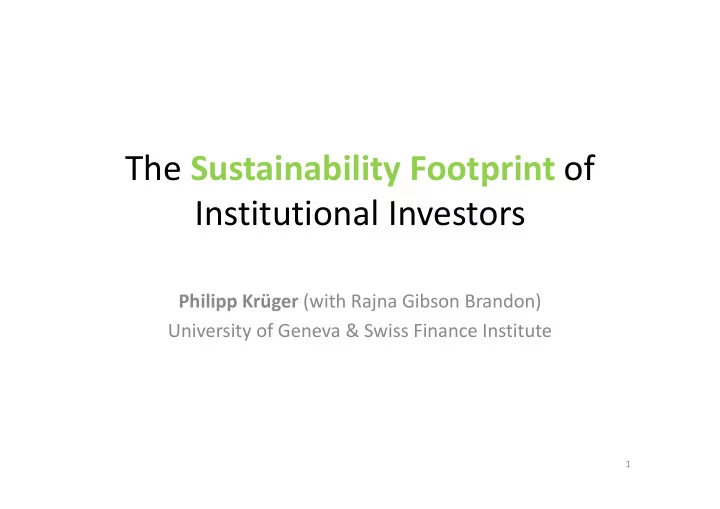

The Sustainability Footprint of Institutional Investors Philipp Krüger (with Rajna Gibson Brandon) University of Geneva & Swiss Finance Institute 1
What do we do in this paper? 1. Propose a way of measuring the portfolio ‐ level sustainability of institutional investors ( “footprint”) 2. Study the link between i. investment horizon and footprint ii. risk ‐ adjusted returns and footprint Gain a better understanding of which types of institutions engage in sustainability oriented investment strategies 2
Measuring sustainability at the stock ‐ level • Environmental and social (ES) ratings from MSCI and Thomson Reuters • U.S. stocks between 2003 and 2015 • Use average MSCI and Thomson Reuters rating 3
Measuring sustainability footprint at the institutional investor ‐ level • Combine (i) portfolio weights with (ii) stock ‐ level sustainability scores • “Footprint”= Value ‐ weighted sustainability of the stocks in the institution’s portfolio: � �� �� ��� ���� ��� • Focus on “ 13F institutions” : institutions that exercise investment discretion over $100 million in U.S. stocks 4
- Very few institutions have good footprints (i.e., only 3 % of institutions have a footprint of 8 or better) Note: The higher the footprint, the better… Figure 1, Panel B 5
1.) Footprint of the average institutional investor has increased by about 65 % between 2002 and 2015 2.) Divergence of E and S footprint since 2010 (BP oil spill?) 6
Institutions with longer investment horizons have higher (i.e., better) footprints Figure 3, Panel A Differences economically meaningful. For example, average Public Pension Fund has a 21% (=5.2/4.3-1) better footprint than the average independent investment advisor. 7
Institutions with lower portfolio turnover have better footprints Figure 3, Panel B Low-turnover institutions have a 38 % better sustainability footprint than high turnover institutions 8
What about the link between risk ‐ adjusted performance and footprints? Institutions with better footprints have… … (iii) … (ii) lower ... (i) lower higher Sharpe risk returns ratios 9
Conclusion 1. Propose new way of measuring the portfolio ‐ level sustainability footprint of 13F institutions 2. Show that investment horizon correlates with sustainability footprints: longer horizons, better footprints 3. Show that institutional investors with better sustainability footprints exhibit higher risk ‐ adjusted performance – primarily through a reduction of portfolio risk 4. IV and a DID identification strategy suggest a causal impact 10
Thank you for your attention! 11
Recommend
More recommend